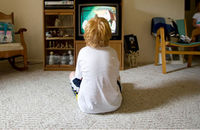by Lianne Castelino www.whereparentstalk.com
How many times have we not all watched tv and had this experience —- believing something is real when it isn’t. You know a commercial that looks and sounds like it could be a a true story. You may become entranced while watching it, moved by the visuals, words, or both and then SLAM – you realize it is a masterfully-created advertisement. It probably happens more than we all think. Now imagine how a young child would process the same messaging?
It’s an interesting thought and one that many parents strongly consider when they decide 1. to restrict tv viewing, 2. not buy cable/satellite, 3. hide the tv remotes during certain hours, 4. place parental controls on their tvs, 5. not have a tv in the house.
These days the sheer power of advertising is something to behold – largely because it is everywhere we turn. Billboards, mobile phones, internet, airplanes. You can even buy a refrigerator with a built-in tv screen if you are so inclined.
Advertising to children has long been a hotly-debated issue with some gains made, but more ground still to cover.
Kids tend to love commercials. And as is the case in my family, they somehow are able to remember the minute details of commercials whether they like them or not. That’s great news for the creative minds that concoct them, but it is cause for reflection for those of us viewing them.
Advertising junk food to kids under 13 is an interesting case and point. A private members’ bill will be put forth today by NDP MPP Rosario Marchese calling for a ban on these types of ads. This will be Marchese’ second attempt at banning unhealthy food ads to kids in this age group. The first came in 2008.
It will be interesting to see the reaction this time around.
After all, the alarms have been sounded, and if you listen closely you can hear them ringing right now. One in 4 kids in Ontario is Ontario. The statistics become increasingly grim as you move nationally and across North America.
How in the world can we expect kids to discern what this type of advertising is telling them? The bright, inviting colours, catchy music, toys, games, freebies, cartoon characters — whatever medley of goodies featured in these ads or used to promote them is what most kids focus on. No need to study it, get a professional opinion or anything else. That’s just basic common sense. The more they are exposed to it, the more they will want it and ask for it —- likely not understanding or unable to comprehend the nutritional value, or unhealthy elements in these food items.
We all eat junk food. There is no crime in that. However, unhealthy choices have to be the exception and healthy choices – the rule — for a host of obvious reasons.
Junk food advertising is one of many contributors to obesity. Why not be proactive and address the symptom rather than the problem.
The litany of health and other issues linked to being overweight or obese costs each of us money, every second of every day.
These junk food advertisers will be just fine if they are prevented from promoting unhealthy foods to kids, thank you. Present and future generations of children however, will not be if it’s allowed to continue.
This is a no-brainer.



